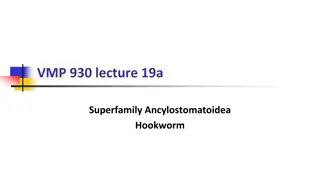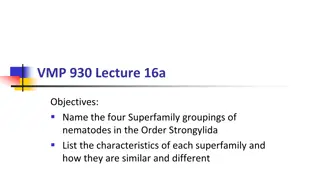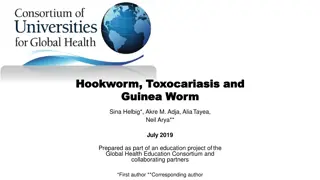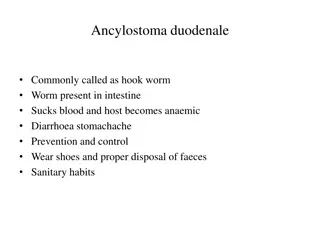Understanding the Hookworm Superfamily Ancylostomatoidea
The superfamily Ancylostomatoidea includes blood-feeding parasites like hookworms, with important species such as Ancylostoma caninum in dogs and Ancylostoma duodenale in humans. These parasites have a complex lifecycle involving transmission through the environment and development within the host.
0 views • 31 slides
Overview of Superfamilies in Order Strongylida Nematodes
The Order Strongylida in nematodes encompasses four main superfamilies - Trichostrongyloidea, Strongyloidea, Ancylostomoidea, and Metastrongyloidea. Each superfamily is defined by distinct characteristics such as buccal cavity size and location within the host, as well as differences in life cycle a
1 views • 34 slides
Overview of Hookworm, Toxocariasis, and Guinea Worm Infections
These infections are significant global health issues affecting millions of individuals worldwide. Hookworm infection, a leading cause of iron-deficiency anemia, is prevalent in tropical and sub-tropical regions. Risk factors include poor sanitation and walking barefoot on contaminated soil. The bio
0 views • 46 slides
Understanding Parasitism in Veterinary Medicine
Parasites can cause significant harm to animals by interfering with normal physiological processes. They can be ectoparasites (external) like mites and ticks, or endoparasites (internal) such as roundworms and hookworms. Diagnosis of parasitism is crucial for effective treatment, with common species
0 views • 27 slides
Common Human Intestinal Parasites and Their Prevention
Ancylostoma duodenale, Wuchereria bancrofti, Dracunculus medinensis, and Enterobius vermicularis are common human parasites causing various diseases. From hookworms to pinworms, these parasites can lead to anemia, filariasis, elephantiasis, and inflammation. Proper sanitation and hygiene practices,
0 views • 9 slides




